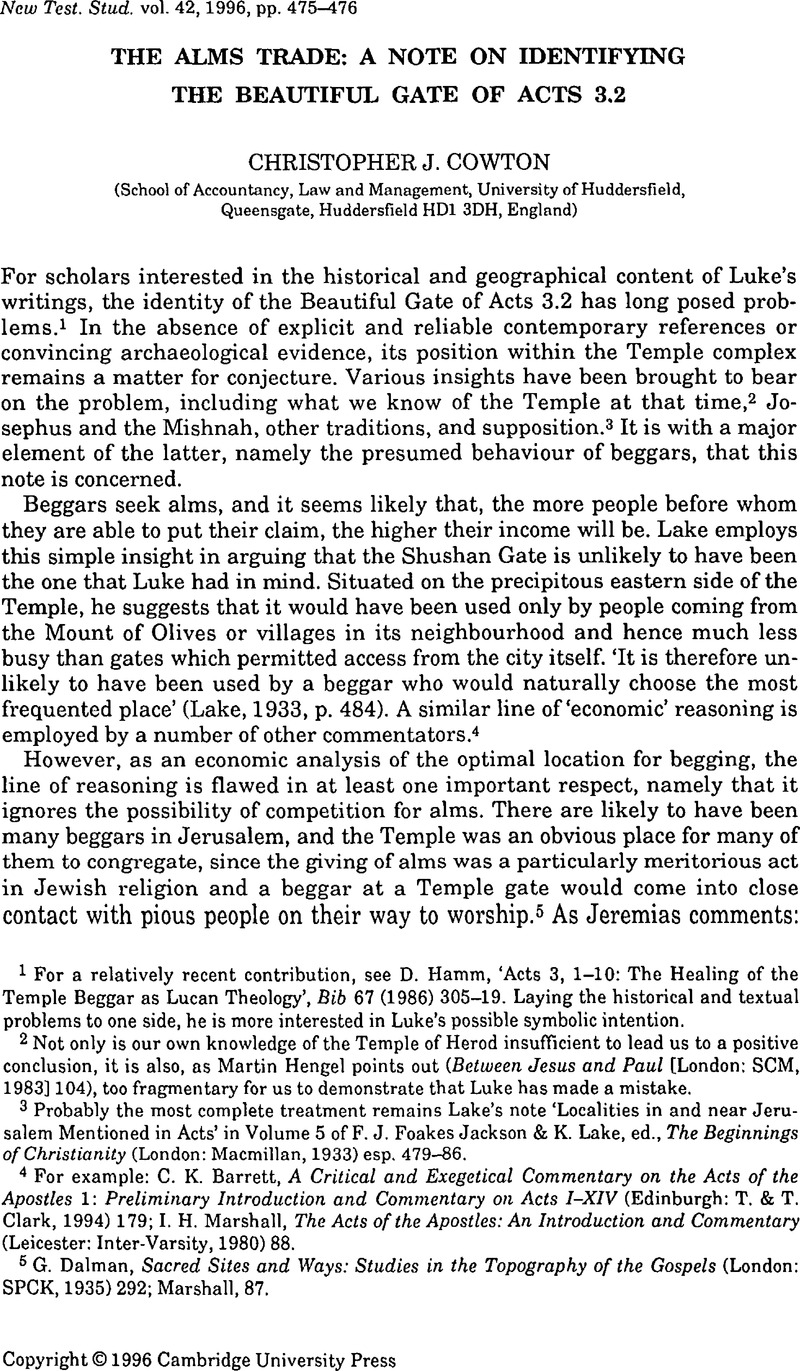No CrossRef data available.
Article contents
The Alms Trade: A Note on Identifying The Beautiful Gate of Acts 3.2
Published online by Cambridge University Press: 05 February 2009
Abstract

- Type
- Short Studies
- Information
- Copyright
- Copyright © Cambridge University Press 1996
References
1 For a relatively recent contribution, see Hamm, D., ‘Acts 3, 1–10: The Healing of the Temple Beggar as Lucan Theology’, Bib 67 (1986) 305–19Google Scholar. Laying the historical and textual problems to one side, he is more interested in Luke's possible symbolic intention.
2 Not only is our own knowledge of the Temple of Herod insufficient to lead us to a positive conclusion, it is also, as Martin Hengel points out (Between Jesus and Paul [London: SCM, 1983] 104)Google Scholar, too fragmentary for us to demonstrate that Luke has made a mistake.
3 Probably the most complete treatment remains Lake's note ‘Localities in and near Jerusalem Mentioned in Acts’ in Volume 5 of Jackson, F. J. Foakes & Lake, K., ed., The Beginnings of Christianity (London: Macmillan, 1933)Google Scholar esp. 479–86.
4 For example: Barrett, C. K., A Critical and Exegetical Commentary on the Acts of the Apostles 1: Preliminary Introduction and Commentary on Acts I-XIV (Edinburgh: T. & T. Clark, 1994) 179Google Scholar; Marshall, I. H., The Acts of the Apostles: An Introduction and Commentary (Leicester: Inter-Varsity, 1980) 88.Google Scholar
5 Dalman, G., Sacred Sites and Ways: Studies in the Topography of the Gospels (London: SPCK, 1935) 292Google Scholar; Marshall, 87.
6 Jeremias, J., Jerusalem in the Time of Jesus: An Investigation into Economic and Social Conditions during the New Testament Period (London: SCM, 1969) 117.Google Scholar
7 It would not be difficult to specify mathematically the joint conditions that would trigger the appearance of a beggar at a gate. Generally, the more uneven the pattern of traffic, the larger the number of beggars required to ensure at least one at every gate.
8 Note too that while Lake and others are sensible in suggesting that more worshippers would enter the Temple from the west than from the east, there were also more gateways on that side (Corbett, S., ‘Some Observations on the Gateways to the Herodian Temple in Jerusalem’, Palestine Exploration Quarterly 84 [1952] 7–14)CrossRefGoogle Scholar, thus reducing the disparity between traffic levels at individual gates.
9 The precise implications of my counter-analysis depend, of course, on the strands of argument remaining and the way in which particular commentators have woven them together.


